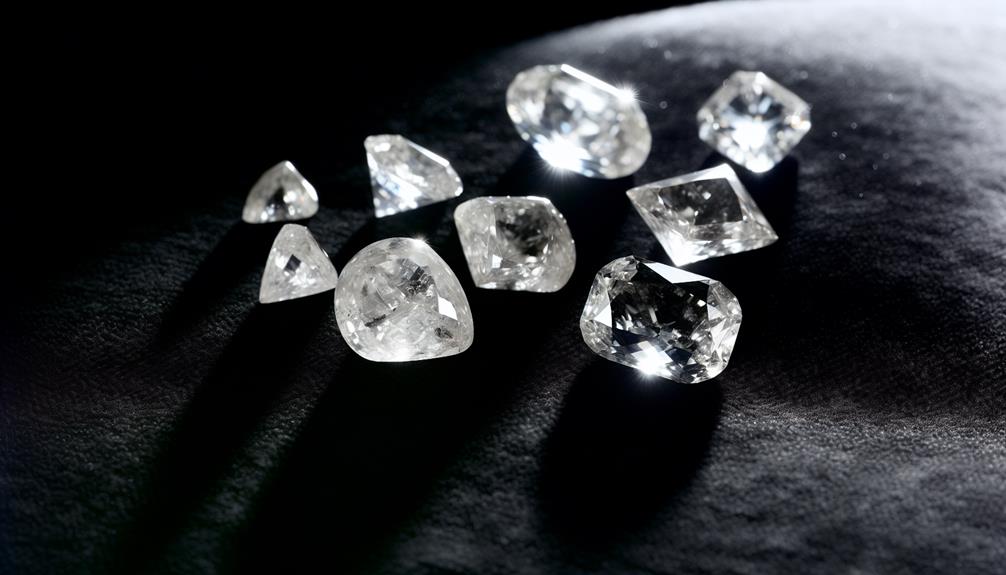In 2024, the diamond market will experience a significant shift towards lab-grown diamonds, driven by their affordability and sustainability. Increased consumer awareness of the environmental impact of traditional mining methods propels this trend. The lab-grown diamond market size is expected to increase at a 10.3% CAGR during the period 2024-2031.
Nevertheless, natural fancy-colored diamonds, such as rare reds and cognac yellows, will continue to see strong demand due to their rarity and uniqueness. Additionally, the market for misfit natural diamonds, characterized by distinct imperfections, is growing.
Due to advanced testing techniques and sustainability considerations, the competition between lab-grown stones and natural colorless diamonds will increase. These trends will shape supply chains and consumer behaviors throughout the year.
Article Contents
Main Highlights Of the Diamond Market in 2024
- Lab-grown diamonds, priced between $500 and $2,000, offer an affordable and sustainable alternative to natural diamonds.
- Natural fancy-colored diamonds, particularly rare reds and pinks, continue to captivate the market due to their rarity and high desirability.
- The increased consumer preference for ethically sourced diamonds significantly influences demand and pricing.
- Unique natural colorless diamonds, such as salt-and-pepper stones, are gaining popularity for their distinctive imperfections.
- Advanced testing technologies that distinguish natural diamonds from synthetic ones are impacting market dynamics by ensuring authenticity and transparency.
Lab-Grown Diamonds in 2024
Lab-grown diamonds have firmly established themselves in the market, providing consumers with an affordable and sustainable alternative to natural stones. The rising demand for ethically sourced gems and increased awareness of the environmental effects of traditional diamond mining are the main factors driving this shift in consumer preferences.
Companies like Adornet Jewels, under the leadership of Siddhant Shah, have seen their customer base double, reflecting a significant market trend towards synthetic diamonds. The competitive pricing of lab-grown diamonds, which frequently range between $500 and $2,000 and appeal to a wide demographic, further supports this trend.
Technological advancements in diamond synthesis have been instrumental in this market shift. As methods for growing diamonds become more efficient, the cost per carat continues to decrease, making these gems more accessible. For example, Anna S. Lipaygo from Lab Grown Diamonds USA LLC notes that per-carat prices have remained mostly stable but are slightly decreasing.
Companies like Silversmiths Inc. are adapting to consumer demand by incorporating lab-grown stones into their product lines, underscoring a clear transformation in market dynamics.
Natural Fancy-Colored Diamonds

Amid economic fluctuations and evolving consumer preferences, natural fancy-colored diamonds continue to captivate the market with their rarity and unparalleled diversity. These diamonds come in a spectrum of colors, each with its unique appeal. Rare red diamonds, for instance, are among the most coveted, with only a few dozen known to exist globally. Cognac yellow diamonds have also maintained their allure, with darker tones generally preferred over lighter ones.
Pastel pink diamonds and treated green diamonds are increasingly popular, reflecting a consumer desire for gems that offer a natural appearance. High-quality pinks, which survive the rigorous High-Pressure High-Temperature (HPHT) treatment, are particularly prized for their clarity and vibrant hue.
Below is a table summarizing key insights into the market for these exquisite gems:
| Color Type | Market Insight |
|---|---|
| Rare Red Diamonds | Extremely rare, high value, very limited supply |
| Cognac Yellow Diamonds | Steady demand, darker tones more popular |
| Pastel Pink Diamonds | Preferred over more saturated treated colors |
| Treated Green Diamonds | Natural appearance drives demand |
| High-Quality Pinks | Survive HPHT treatment, valued for clarity and vibrant hue |
Despite competitive pressures from synthetic diamonds, the natural fancy-colored diamond market remains buoyant, driven by a blend of rarity and consumer sophistication.
Natural Colorless Diamonds: The Next Few Months
The natural colorless diamond market is set for notable adjustments due to lab-grown alternatives‘ rising popularity and affordability. Due to increased market competition and the need to remain competitive with synthetic alternatives, current pricing trends show a general decrease in the per-carat costs of natural diamonds over a carat. Despite this, consumer preferences for natural diamonds persist, particularly among those who value authenticity and origin.
Market competition has intensified as lab-grown diamonds offer high quality at more accessible prices. Advanced diamond-testing technologies have been developed to distinguish between natural and synthetic stones, addressing concerns about market integrity. Additionally, sustainability initiatives are influencing consumer choices, as buyers become more conscious of the environmental impact of diamond mining compared to the controlled production of lab-grown diamonds.
Ari Jain of House of Diamonds, Inc. notes that global diamond demand is unstable due to geopolitical conflicts, affecting traditional buyer demographics. However, the enduring allure of natural diamonds, combined with adaptive pricing strategies, suggests that natural colorless diamonds will continue to hold a significant market presence.
This evolving landscape underscores the importance of strategic adaptation and innovation for natural diamond sellers in the coming months.
Misfit Natural Colorless Diamonds

In response to the growing prevalence of lab-grown diamonds, the market for misfit natural colorless diamonds, such as salt-and-pepper stones, has seen a significant surge in popularity. These diamonds, known for their unique characteristics and internal features, offer a distinct alternative to the flawless appearance of synthetic gems.
As lab-grown diamonds become more common, consumers are increasingly drawn to the individuality and intrinsic beauty of these misfit stones, which cannot be replicated in a laboratory setting.
The rising popularity of misfit diamonds is also fueled by a burgeoning sustainability niche. Companies like Bjorn Salt & Pepper Diamonds and OM Imports Inc. are thriving by offering stones with one-of-a-kind internal features, appealing to buyers who value exclusivity.
Unlike their synthetic counterparts, misfit diamonds are celebrated for their imperfections, which add to their charm and desirability. This segment of the diamond market has experienced considerable growth, driven by consumers who desire freedom from conventional standards of perfection.
As a result, jewelry featuring salt-and-pepper diamonds and other off-color stones is now more sought after than ever, carving out a unique place in the evolving diamond industry of 2024.
Supply Constraints and Gluts
Navigating the complex terrain of the diamond market, industry stakeholders encounter challenges stemming from fluctuating supply constraints and periodic gluts. These fluctuations often result from the dynamic interplay between global demand, price variations, and evolving market trends. The issue of ethical sourcing further complicates the supply chain, as consumers increasingly prefer responsibly sourced diamonds.
Two significant factors influencing the market are the rising popularity of lab-grown diamonds and the enduring appeal of natural fancy-colored diamonds. Lab-grown diamonds, driven by competitive pricing and technological advancements, have expanded customer bases and influenced price trends in both synthetic and natural diamond markets. However, global economic instability and geopolitical conflicts also impact diamond buyers, adding unpredictability to supply and demand dynamics.
| Supply Factor | Market Impact |
|---|---|
| Global Demand | Drives price fluctuations |
| Ethical Sourcing | Shapes consumer preferences |
| Market Trends | Influences supply chain |
| Price Fluctuations | Affects consumer behavior |
To navigate these complexities, industry stakeholders must adapt by closely monitoring market trends and adjusting strategies accordingly. The appeal of unique, natural diamonds and the competitive pricing of synthetic options highlight the need for flexibility. As the market evolves, understanding these factors will be crucial for sustaining growth and meeting consumer expectations in 2024.
Our Thoughts on the Diamond Market in 2024
As we look ahead to the rest of 2024, the diamond market is undergoing remarkable changes driven by technological innovations and shifting consumer preferences. Laboratory-grown diamonds now make up around 40% of global sales, reflecting their growing acceptance and competitive edge. This change reveals a dynamic market environment where natural and synthetic diamonds compete for consumer interest under the influence of societal trends and shifting tastes.
In our view, the industry faces significant challenges, particularly in balancing supply and demand while ensuring rigorous authenticity verification. It’s a dynamic period for the diamond market, with both opportunities and hurdles ahead.






